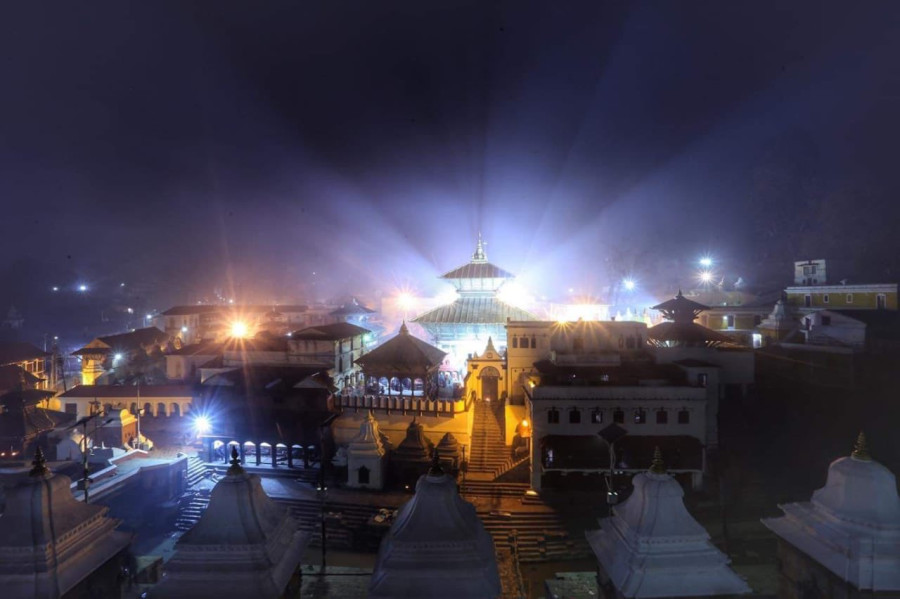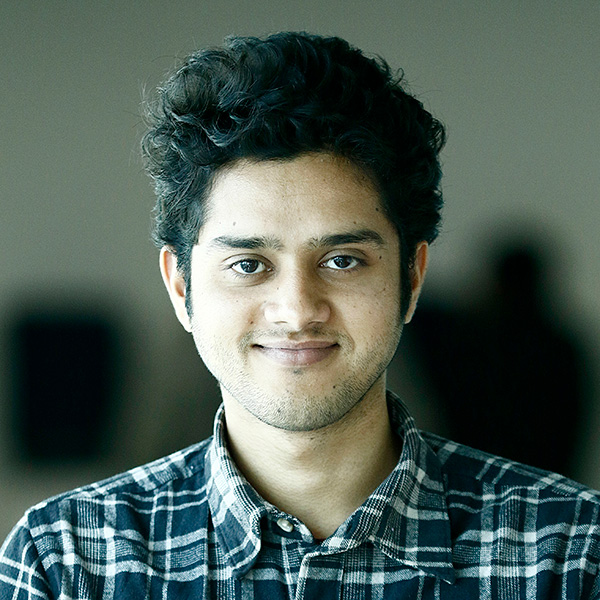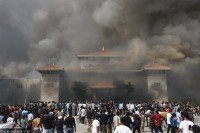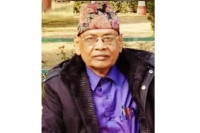Valley
On Shivaratri, all are welcome, none are turned away
It is a cloudy Saturday evening and the skies are as grey as the chillum smoke lazily circling Madanlal Goswami Pandit and Bablu Goswami Pandit. The two sit side-by-side at the Ram Mandir in Pashupatinath, taking long, deep drags from a short stubby chillum that they clutch between their fingers.
Timothy Aryal
It is a cloudy Saturday evening and the skies are as grey as the chillum smoke lazily circling Madanlal Goswami Pandit and Bablu Goswami Pandit. The two sit side-by-side at the Ram Mandir in Pashupatinath, taking long, deep drags from a short stubby chillum that they clutch between their fingers.
Madanlal and Bablu are guru-chela, master and student, an ancient and holy covenant between ascetics. Both sport long beads, their foreheads lined with ash and their robes saffron. Madanlal is 50 and has been regularly visiting Pashupatinath on Shivaratri for the past 12 years. For Bablu, 32, it’s only been six years.
They arrived here together on Friday, with just two blankets, two bed covers and some ganja. They now sit by the fire-which they call the “shivadhuni”—offering prayers to lord Bholebaba, Neelkanth, Nataraj, the destroyer, Pashupatinath, god of gods.
 A foreigner poses for a photo with a sadhu.
A foreigner poses for a photo with a sadhu. “Shivaji is nirakar and grants our wishes,” Madanlal said, “It’s imperative that we keep him happy by worshipping him and offering what we have.”
Every year, thousands of ascetics like Madanlal and Bablu make an annual pilgrimage to the Pashupatinath Temple. They come from all over Nepal and India, by foot, on buses, in cars and even planes. On Shivaratri, a night dedicated to the deity many Hindus consider the supreme being, all are welcome, none are turned away.
Enter two Bachelor’s students from Trichandra College, hesitating, nervous. They’re debating whether to ask Madanlal and Bablu for a drag on their chillum. They come here every year, they say. Madanlal invites them excitedly, offered a vibhuti across their foreheads and quickly loads the chillum. The youngsters take turns, exhaling long plumes of smoke.
 A sadhu takes a drag of marijuana from a chillum.
A sadhu takes a drag of marijuana from a chillum.“The whole idea of this buti is to share it,” says Madanlal. “Whoever comes asking for it, we provide. Bholebaba is happy when his buti is shared, never sold.”
Despite the propensity of the sadhus to smoke and share the bountiful herb, the Nepal government doesn’t share their open-mindedness. This year, there is a “complete ban” of any kind of intoxicant, says Pradeep Dhakal, member secretary of the Pashupati Area Development Trust.
“While in previous years, there used to be a significant number of youngsters who would come here only to smoke ganja, that has changed this year,” Dhakal said. “We’ve banned ganja smoking even among sadhus.”
But the ban didn’t seem to have been enforced too rigorously. The sadhus the Post talked to said that since the holy herb is a prasad from the Mahadev, they continue to smoke it.
Madanlal, too, smokes and as he smokes, he talks. He became a sage by choice, he says. At the age of 22, he renounced all material wealth and decided to walk the path of the renunciate. “I was more interested in singing bhajans and worshipping bholenath,” he says.
Shivaratri attracts people like Madanlal—those who feel like they don’t belong behind a desk, slogging away for long hours in front of a computer, or those who feel there is more to life than the material, or those who simply want to smoke some herb and while the night away.
 Visiting ascetics collect wooden logs to make bonfires known as 'shivadhuni'.
Visiting ascetics collect wooden logs to make bonfires known as 'shivadhuni'.Take, for instance, the Mala Baba, a pale white man, who professes more faith in the Hindu religion than most Hindus.
“I experience a kind of epiphany every time I perform a pooja, and on Shivaratri it’s magical,” says Mala Baba in English.
“It’s a magical experience. Say, a miracle, it’s like magic.”
Mala Baba is Canadian and he’s been coming here for 10 years. Once, long ago, who remembers when, he was taken into custody by police when he was returning from worship. “You know why they didn’t see me while I was entering and only saw me when I was returning?” he asks. “Because the Mahadev, the almighty, made them blind.”
“He’s not Mala Baba, he’s Canada Baba,” a sage sitting alongside guffaws.

This year, the number of sadhus is expected to increase, says Dhakal. Previously about 5,000 sages visited Pashupati; this year, it’s bound to swell to 12,000, as most of them will be coming straight from the Kumbh Mela in India, says Dhakal.
This swell of people means big business for Prakash KC, who’s set up a small shop by the Bhasmeswore Ghat, selling noodles, biscuits and chocolate candies. “Of course, things sell better on Shivaratri than other times,” he says. “Candies sell the most, probably because most of the youths are high.”
Then again, for others like 27-year-old Shivanath, it’s an opportunity to serve the world. His group, the Shree Shivam Sewa Mandal, operates under the slogan “Sewa nai dharma ho” (To serve is our religion), and has set up a tent, serving food for free.
With ganja to burn and free food to satisfy any craving, Bablu and Madanlal are happy. But Bablu has some issues. “The problem with water and latrines is very stark here,” says Bablu, very uncharacteristic for an ascetic. For Madanlal, however, everything is fine as long as Shiva is venerated. “Anything we wish for, Bholenath provides,” he says.
Photos: Elite Joshi and Hemanta Shrestha




 12.12°C Kathmandu
12.12°C Kathmandu










